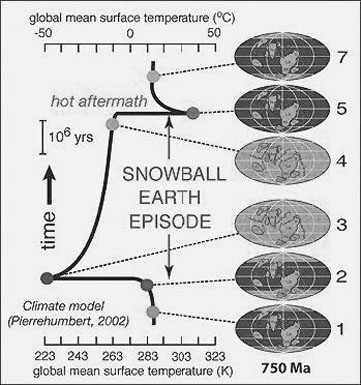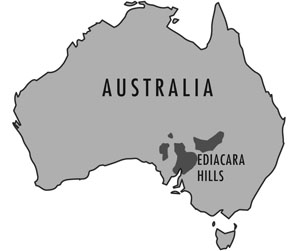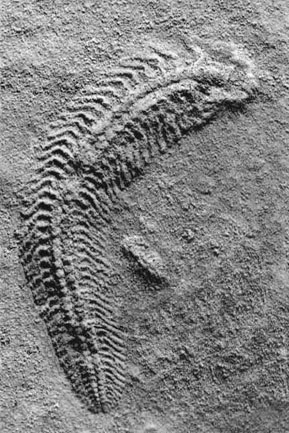A New History of Life (16 page)
Read A New History of Life Online
Authors: Peter Ward

As we saw in an earlier chapter, the first snowball Earth episode (beginning at about 2.35 billion years ago) seems to have been caused by life: the explosive rise of cyanobacteria caused a reduction in the greenhouse effect of the atmosphere’s methane and carbon dioxide content. The start of this second and final series of snowball Earth events of Earth’s long history to date occurs within the Cryogenian time period described in chapter 1. Due to recent work on calibrating the Cryogenian, we know now that there were most likely two major events beginning 717 million years ago and ending 635 million years ago. The start of this second and final series of snowball Earth events
is essentially in the middle of what is now formally defined as the Cryogenian period in the geological time scale (it begins prior to a pair of sharp isotope shifts slightly older than 800 million years ago, which are the result of a true polar wander oscillation).
Both of the differing snowball Earth episodes (each made up of ocean freezing and then thawing events) caused a severe decline in marine organic production, because the sea ice would block out sunlight. Thus, the amount of life on Earth, as measured by its overall mass (known as biomass), shrunk to tiny values compared to both before and after the events themselves. The succession of snowball glaciations and their ultragreenhouse terminations during both the periods from 2.35–2.22 billion years ago and from 717–635 million years ago must have imposed a severe environmental filter on the evolution of life. The fossil record provides few clues, but the acritarchs first described in the last chapter (planktonic organisms of small size) waxed and waned in both diversity and abundance.
Many living organisms are known to respond to environmental stress by wholesale reorganization of their genomes, and any snowball Earth event would have been stressful, to say the least. The
developmental and evolutionary significance of such genomic changes are hot topics of research in molecular biology. The fact that diverse fossils of more complicated organisms than were there before the onset appear in the immediate aftermath of the snowball glaciations supports the notion that the snowball events created some sort of an ecological trigger for vast changes in the complexity of life and its diversity.

Diagram showing the rate of temperature increase and decrease over time in the Snowball Earth episodes.
One of the most profound of all questions relating to the snowball Earth events relates to their cause. Earlier we noted that the first snowball Earth episode might have been triggered by life itself: the invention of oxygenic photosynthesis, which would have caused a rapid depletion of greenhouse gases. But there may have been a quite different reason for the onset of the second episodes, occurring well more than a billion years after the first. The second snowballs may have been triggered by the movement and tectonic activity of continents of the time.
4
The so-called Neoproterozoic snowball events, the most recent of the two grand snowball Earth episodes, occurred around 40 million years after the great continental amalgamation—called the supercontinent Rodinia (an amalgamation of every continent into one continuous landmass)—began to disintegrate. Supercontinents tend to have arid climates because most of their land area is far from the ocean. Conversely, when continents and especially supercontinents separate, maritime climates displace formerly arid regions, creating the potential for increased chemical weathering. Chemical weathering of silicate rock minerals causes a rapid reduction of carbon dioxide levels in the atmosphere. As CO
2
drops, so too does temperature. This second time it may not have been life so much as inorganic chemical reactions. Interestingly enough, the onset of the second snowball event (called the Sturtian after exposures in Australia) coincides rather precisely with the eruption of a massive volcanic province in Canada, at 716.5 million years ago.
5
Although some CO
2
is emitted from eruption of these large igneous provinces, when they erupt on land the drawdown of gases far exceeds the volcanic input, bringing the system closer to a planet getting so white that most sunlight is reflected back into space. And that produces ever more cold.
But perhaps this is not the whole story. If it could be shown that some new kind of plant life suddenly and radically increased in numbers across the globe, once again the possibility arises that the sudden reduction of carbon dioxide by photosynthesis, rather than chemical weathering, was involved. In fact this may have been the case. Some of the newest of all understandings about the history of life is that land plants, still only single celled but nevertheless potentially extending over vast areas of land, appeared around 750 million years ago. This would have done the trick.
What would have happened to the life on Earth of about 750 to somewhat more than 600 million years ago by the change from a world of ocean and land to one of snow, ice, and bare rock? A simple thought experiment suggests that both the abundance and the diversity of life on Earth found just before these Proterozoic-era snowball Earth events would have diminished. The life then was largely of the single-celled variety, although by this time multicellular plants such as the common kelp and alga (green and red) that adorn so many seashores of our world would have been present too. But much of life was composed either of single-celled protozoa, all eukaryotes, or vast sheets of bacterial slicks and growths both as near-shore stromatolites and other masses of cyanobacteria, and also huge biomasses of single-celled, photosynthetic microbes in the seas. On land, we speculate that single-celled, perhaps even more complex assemblages of photosynthetic organisms, including great sheets of microbes, would have inhabited freshwater, and would perhaps appear liberally on damper land surfaces. Soils as we know them would not have yet existed, but certainly the chemical weathering of rock surfaces, incorporating the dead and rotting bodies of what plants there were would have added organics to the clays and sand of the surface of the land. And then onto
both the surface of the sea and that of the land came ice for the former, and for a while ice and certainly cold to the latter.
The extinction potential in terms of biomass is easy to imagine and fathom. Kilometer-thick ice covering the sea surface would have greatly reduced sunlight. While there is microbial life in ice, and in fact some sun does filter through sea ice, surely the biomass of plant life would have plummeted. The loss of sunlight was one part, but perhaps as significant would have been the loss of important nutrients, the all-important iron, nitrates, and phosphates of our world. As the land surface cooled and in many parts came to be covered in snow and ice, chemical weathering slowed, as did the vigor and abundance of land “plants” of whatever kind there were (this is, of course, hundreds of millions of years before true, complex land plants with stems and leaves). But the land would have produced far less fertilizer getting to the sea. Ocean productivity plummeted, and as it did so, surely mass extinction not only of individuals but also of whole species followed.
Yet from this scenario comes a model that perhaps answers the question of why there are so many kinds of animals. Although the entire ocean surface would have frozen with pack ice, in fact the world then had far more volcanic activity than it does now. There would have been many hot springs, geysers, and especially active volcanoes blasting heat into oceans, and in so doing producing small warm bodies of open water, free of ice. Surrounded by icebergs and finally frozen sea, these small “aquaria” would have been isolated, and being scattered around the world, subject to many kinds of different environmental conditions. Evolution works best on small, isolated populations. Thousands of these small marine and even freshwater refuges would have been evolutionary incubators, using the principle of “genetic bottlenecks” (where tiny populations, when isolated, can quickly evolve because of their small number of genes). In this way, protozoa, those small single-celled eukaryotes, may have evolved into many different kinds of
metazoans—
animals. With the release of the snowball conditions, caused by the eventual buildup of greenhouse gases from all of those active volcanoes, there would have been rapid melting
of the ice, as well as a rapid release of these thousands of new evolutionary experiments.
Earth came out of its last snowball 635 million years ago, a place very different from the planet we know today. But forces—both evolutionary and physical—were under way that would make our Late Proterozoic Earth much more Earthlike, in the sense that we know it. The oceans were teeming with life: most were single celled, but largely composed of the complex Protozoa, such as amoeba, paramecia, and the enigmatic half plant half animals such as multicellular Volvox and single-celled Euglena. The shores and sea bottoms were festooned with various kinds of kelp, more formerly the large, multicellular red and green algae so common on Earth,
still
so common on Earth. The stage was set for the evolution of the first animals. Around 635 million years ago that process began. We think. The newly named Ediacaran period began at the end of the last snowball and ended with the appearance of creatures that were unquestionably animals. It also is the last formal time interval immediately before the start of the Paleozoic Era. The time is named after its most important denizens, then the most complex organisms to have ever evolved. We call them Ediacarans.
6
These iconic fossils of this latest Precambrian time—the last part of the Proterozoic era—reveal a wide variety of peculiar body types unlike anything alive today. Once known only from the Ediacaran Hills of South Australia, there are now numerous places on Earth where
these enigmatic fossils are known to be found. But the best remains the low hills north of Adelaide.

The Ediacaran Hills are part of the largest mountain range in the southern part of Australia, the Flinders Ranges. Like so much of Australia away from the more verdant coast, much of the Flinders Ranges is composed of sand, rocky outcrops, and scattered vegetation adapted to a semiarid environment. Here and there larger trees dot the landscape, including sugar gum, cypress pine, and black oak. Year-round water holes are scarce, but when found, a rich assemblage of the iconic Australian fauna is abundant; red and western gray kangaroos have flourished in the area since the eradication of the carnivorous dingoes, their most dangerous predator at one time. Even the once-endangered yellow-footed rock wallabies can now be seen with regularity. But it is not the kangaroos and the other smaller marsupials that make this place special; it is the ancient fossil fauna.
Along with the Burgess Shale of Canada, Solnhofen Limestone of Germany, and the Hell Creek Formation of North America, the Ediacaran Hills is arguably one of the four most famous fossil sites in
the world. Ranging between 560 and 540 million years in age, these hills contain the record of what most paleontologists agree are the first-known body fossils of animals.
